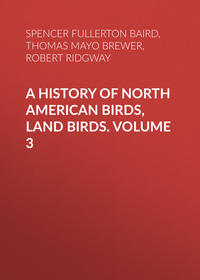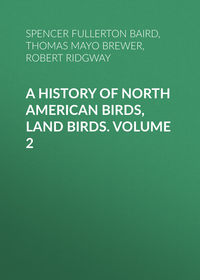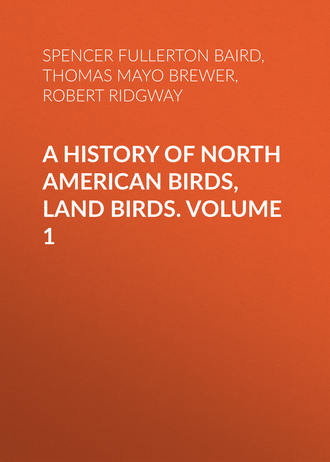 полная версия
полная версияA History of North American Birds, Land Birds. Volume 1
Two nests of this interesting species were also obtained near Camp Grant, Arizona, in 1867, by Dr. E. Palmer. They are wrought like all the nests of this kind, below the small forked branches of a tree, suspended from the extremity of its twigs. They each have a diameter of about three and a half inches, a height of two, with a cavity an inch and a half deep and two wide. The external portion, like the nests of the V. belli, is wrought with woven hemp-like vegetable fibres, strongly bound around the ends of the twigs and covering the entire exterior. Within this is placed a strong, firmly made basket, composed of slender strips of bark and long, fine, and flexible pine-needles, with a lining of finer materials of the same. In one of these nests there were three eggs of the Vireo, and one of a Molothrus (obscurus?). The former were of a bright crystalline whiteness, marked with very minute and hardly discernible spots of red, and measure .69 by .56 of an inch. The egg of the Molothrus, except in its much smaller size, is hardly distinguishable from those of the common M. pecoris, and measures .75 by .56 of an inch.
In the other nest were also three eggs of the Vireo. They correspond in size, but are much more distinctly marked with larger spots of a dark red and reddish-brown. In this nest there is a somewhat larger proportion of fine strips of inner bark, and mixed with these are also a few silky insect cocoons, by means of which the nest is firmly bound around the twigs from which the whole is suspended.
Vireo vicinior, CouesARIZONA VIREOVireo vicinior, Coues, Pr. A. N. Sc. Phila. 1866.—Baird, Rev. Am. B. 361.—Elliot, Illust. Birds N. A. I, vii.—Cooper, Orn. Cal. 1, 1870, 125.

Vireo vicinior.
40697
Sp. Char. (No. 40,697 ♂.) Bill stout, considerably compressed and deep. Wings moderately pointed, about equal to tail, which is decidedly graduated; first quill rather more than half the second, which about equals ninth and the secondaries; the fourth and fifth longest. Tarsus considerably longer than middle toe and claw; lateral toes quite conspicuous for their disproportion, the inner claw reaching only to base of outer, and falling short of base of middle; the terminal digit of inner toe reaching only to end of second joint of middle toe.
Upper parts, with sides of head and neck, ashy or light plumbeous, faintly olivaceous on rump. Beneath white; slightly ashy on sides of breast. Flanks and inside of wings showing a faint trace of yellow, only appreciable on raising the wings. An obsolete line from bill to eye, and a more distinct ring round the eye, white. No bands on the wing, except a faint edging of whitish on the greater coverts; the quills edged internally with white. Bill and legs plumbeous. “Iris brown. Mouth livid, bluish-white.” (Coues.)
Fresh specimen: Total length, 5.60; expanse of wings, 8.60. Prepared specimen: Total length, 5.10; wing, 2.50; tail, 2.60, its graduation, .22; difference of tenth and longest quills, .40; exposed portion of first primary, .85, of second, 1.65, of longest (measured from exposed base of first primary), 1.95; length of bill from forehead, .50, from nostril, .32, along gape, .61; depth of bill, .18; tarsus, .72; middle toe and claw, .51, claw alone, .16; hind toe and claw, .40, claw alone, .19.
Hab. Prescott, Arizona.
This species might at first sight be taken for a small specimen of V. plumbeus, the colors, character of bill, etc., being very similar, except that the white of lores and around eye is much less distinct, the lore without any blackish before the eye, and there is only one faint band on wing, instead of two conspicuous ones; the tail-feathers, too, lack the distinct white edgings. The much more rounded wing, and the first primary half the second or more, will, however, readily distinguish them. The form of the bird is very much that of V. pusillus, which it resembles considerably also in color. The outer quill is, however, longer, the bill deeper and more compressed, the inner lateral toe considerably shorter, and the size larger. The colors are purer, without the olive of the back or the yellowish of the under parts; the bill, too, is entirely dark plumbeous, instead of horn-color, whitish beneath. From V. pallens it is distinguished by a smaller, darker bill; longer tail and wing; one wing-band, not two; and purer colors.
Habits. In regard to the habits of this well-marked but very rare species but little is as yet known. It was first described, in 1866, by Dr. Coues, from a single specimen obtained by him near Fort Whipple, Arizona. It was shot May 4, 1865, and is supposed by Dr. Coues to be a summer resident of Arizona wintering in the Gila and the Lower Colorado Valleys, or in Sonora.
Family AMPELIDÆ.—The Chatterers
The characteristics of the Ampelidæ have already been presented in the synopsis of allied families; chief among them, the short, broad, depressed, and triangular bill with short gonys, the deeply cleft mouth, the short tarsus, and the tendency to subdivision of its lateral plates.
The South American genus, Dulus, probably forms the type of a subfamily Dulinæ, characterized by the much arched gape of mouth, the metatarsal scutellæ in two series, and the body streaked beneath, as in young Ampelis. The two other subfamilies may be defined as follows:—
SubfamiliesCommon Characters. Grape of mouth nearly straight. Metatarsal scutellæ in three series. Body plain beneath.
Ampelinæ. Wings very long and much pointed, longer than the short, even tail. First primary excessively rudimentary; the outermost about the longest. Gape without bristles. Frontal feathers extending forward beyond the nostrils.
Ptilogonatinæ. Horny appendages like red sealing-wax at end of shaft of secondaries. Wings rounded, shorter than the graduated tail. First primary nearly half the second. Gape well bristled. Frontal feathers falling short of the nostrils. No red horny appendage to wing-feathers.
Subfamily AMPELINÆ
Char. Legs moderate. Nostrils elongated, linear, with the frontal feathers extending close to the edge and to anterior extremity, concealing them; these feathers short, velvety, and erect, with few bristles. Wings very long and acute; outer or first primary so much reduced as to be almost inappreciable; the second nearly the longest. Wing nearly twice the length of the short, narrow, even tail. Under coverts of tail reaching almost to its tip. Secondary quills with flat horny appendages at end of shaft like red sealing-wax. Young birds streaked beneath as in Dulus. Adults plain.
Of this family as restricted, we have but a single genus in America.
Genus AMPELIS, LinnAmpelis, Linn. Syst. Nat. 12th ed. I, 1766, 297. (Type, Lanius garrulus, L. Named Linnæus in 1735.)
Gen. Char. Tail even. Tertials and secondaries with horny appendages like red sealing-wax. A well-developed soft crest.
A more elaborate diagnosis of this genus could be readily given (see Rev. Am. Birds, 404), but the above characters, as entirely peculiar, will serve to establish it.
SpeciesCommon Characters. A lengthened crest of soft blended feathers. Colors, soft silky brownish becoming more vinaceous anteriorly, and ashy posteriorly above. A black stripe on side of head, from nasal feathers across lores through the eye and behind it beneath crest, and a patch of the same on chin, with a white streak between them, on side of lower jaw.
A. Wing variegated. Lower tail-coverts rufous. Crest much developed. Forehead and side of head bright purplish-rufous. Black patch covering whole throat, and sharply defined. No white line between black of lore, etc., and brown of forehead. Inner webs of primaries tipped narrowly with white.
a. Terminal band of tail red.
A. phœnicopterum. 79 Greater coverts tipped with red, producing a band across the wing. No yellow on tips of primaries. Hab. Japan and Eastern Siberia.
b. Terminal band of tail yellow.
A. garrulus. Secondaries and primary coverts tipped with white, forming two broad short bands. Primaries with outer webs tipped with yellow. Hab. Arctic regions of both hemispheres; in winter south into northern United States, and along Rocky Mountains as far as Fort Massachusetts, New Mexico.
B. Wings unvariegated. Lower tail-coverts white. Crest moderately developed. Forehead, etc., not different from crest. Chin only black, this fading gradually into the brown of throat. A white line between black of lore, etc., and brown of forehead. Inner webs of primaries not tipped with white.
a. Terminal band of tail yellow.
A. cedrorum. Wing bluish-ashy. Hab. Whole of North America, from 52° N., south (in winter?) to Guatemala; Jamaica and Cuba in winter.
Ampelis garrulus, LinnNORTHERN WAXWING; BOHEMIAN CHATTERERLanius garrulus, Linn. “Fauna Suecica 2, No. 82.”—Ib. Syst. Nat. 10th ed. 1758, 95. Ampelis garrulus, Linn. Syst. Nat. 12th ed. 1766, 297 (Europe).—Baird, Birds N. Am. 1858, 317; Rev. 405.—Boardman, Pr. Bost. Soc. Nat. Hist. IX, 1862, 126 (Calais, Me.).—Cooper, Pr. Cal. Acad. II, 1861 (1863), 122 (Fort Mohave, Ar.). Bombycilla garrula, Bon. Zoöl. Jour. III, 1827, 50.—Rich.—Aud. Orn. Biog. IV, 462, pl. ccclxiii.—Ib. Birds Am. IV, 169, pl. ccxlvi.—Maynard, B. E. Mass., 107.—Dall & Bannister, 280 (Alaska).—Cooper, Orn. Cal. 1, 1870, 127.—Samuels, Birds N. Eng. 264. Bombycilla garrula, Keys. & Blas. Wirb. Europas, 1840, 167.—Degland, Ornith. Europ. I, 1849, 349 (European).—Wolley, Pr. Z. S. 1857, 55 (nest and eggs).—Newton, Ibis, 1861, 92, pl. iv (nesting).—Nordmann, Cab. Jour. VI, 1858, 307, and VII, 1859, pl. i (nesting). (European.)
Other figures: Bon. Am. Orn. III, pl. xvi.
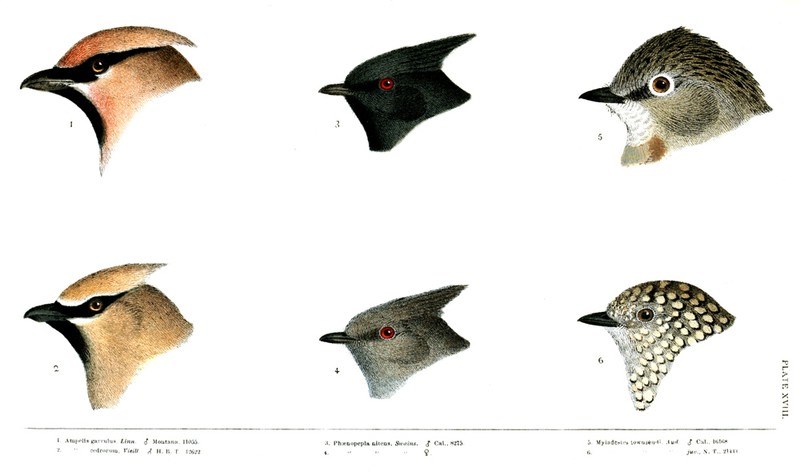
PLATE XVIII.
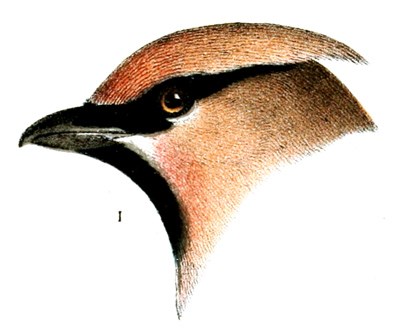
1. Ampelis garrulus, Linn. ♂ Montana, 11055
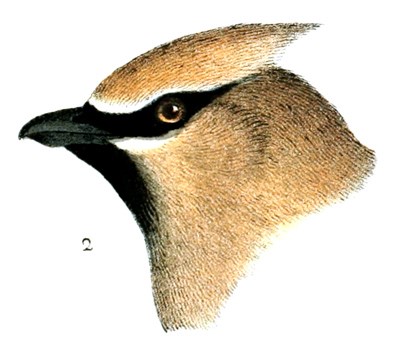
2. Ampelis cedrorum, Vieill. ♂ H. B. T., 42622.
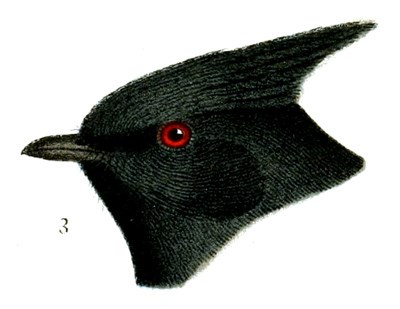
3. Phænopepla nitens, Swains. ♂ Cal., 8275.
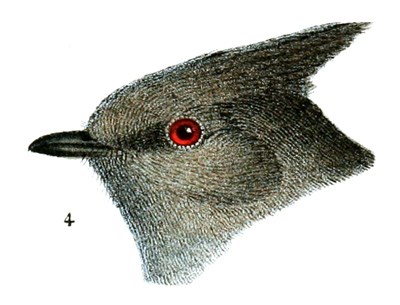
4. Phænopepla nitens, Swains. ♀.

5. Myiadestes townsendi, Aud. ♂ Cal., 16168.
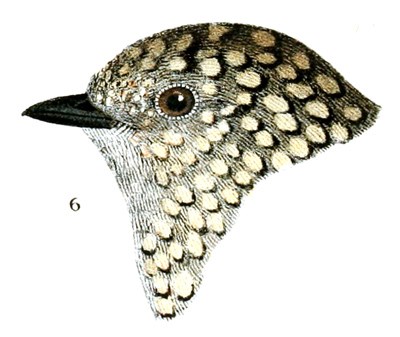
6. Myiadestes townsendi, Aud. juv., N. T., 21444.
Sp. Char. Crest lengthened. Body generally soft, silky brownish-ashy, with a purplish cast, the wing-coverts and scapulars more brownish, becoming more reddish anteriorly and ashy posteriorly; the rump and upper tail-coverts, as well as the secondaries, being nearly pure ash. Anteriorly the color passes gradually into deep vinaceous-chestnut on the forehead to behind the eye and on the cheeks; abdomen yellowish-white. Lower tail-coverts deep chestnut. A stripe on side of the head, covering the lores and nasal feathers (scarcely meeting across the forehead), involving the eye and continued back toward the occiput and beneath the crest, with a large patch covering the chin and throat, deep black; a narrow crescent on lower eyelid, and a short stripe between the black of the throat and that of the chin at the base of the lower mandible, two very broad bars on the wing, one across ends of primary coverts, and the other across ends of secondaries (the first occupying both webs, and the latter the outer), white. Primary coverts, primaries, and tail slaty-black, the latter growing gradually ashy basally. A broad band across end of tail, and a longitudinal space along end of outer web of primaries, gamboge-yellow,—the marks on primaries, however, sometimes white, only stained with yellow. Each of the secondaries with an expanded continuation of the shaft, in form of flattened, very thin, somewhat elliptical appendages, of a bright vermilion-red resembling red sealing-wax. Male with the white of outer web of primaries continued around end of inner webs also. Female without white on terminal edge of inner webs of primaries, and with the “sealing-wax” appendages smaller. Young not seen. Length, 7.40; wing, 4.50; tail, 3.00.
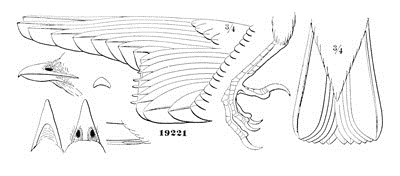
Ampelis garrula.
19221
Hab. Northern parts of Europe, America, and Asia. In America not hitherto found in the Pacific Province. In winter extending along the Rocky Mountains and the Plains as far south as Fort Massachusetts and Fort Riley; regular visitor to shores of Lake Michigan and Lake Erie. East of this rarely seen along the United States border. Fort Mohave (???) (Cooper).
The specimen seen by Dr. Cooper, at Fort Mohave, if really of this species, fixes the most western locality on record.
For many years authentic eggs of the Bohemian Chatterer were greatly sought after, but it was not until 1856 that any were brought to the notice of the scientific world, when the late Mr. H. Wolley discovered them in Lapland. Early duplicates from his collection were sold at five guineas each, and although a good many have since been obtained, they are yet considered as great prizes. A nest, with its eggs, of those collected by Mr. Wolley, has been presented to the Smithsonian Institution by Mr. Alfred Newton. The only instances on record of their discovery in America are of a nest and one egg by Mr. Kennicott, on the Yukon, in 1861, and a nest and single egg on the Anderson River, by Mr. MacFarlane, both of which, with the female parents, are in the possession of the Institution. Although there is frequently considerable difference between individuals, there appears to be no difference between those from the two continents.
Habits. The Waxwing is, in many respects, one of the most interesting and remarkable of the birds of North America. The roving character of its life, the mystery, still only imperfectly solved, of its habits and residence during its breeding-season, and its somewhat cosmopolitan residence in Europe, Asia, and America, impart to it an interest that attaches to but few other species. Though not common in any portions of the United States, and only appearing at all during midwinter, yet in the more northern States, in which it is occasionally found, it moves in such large flocks, and is so noticeable and conspicuous a bird, that it never fails to make a lasting impression, and hardly seems to us so very rare as it undoubtedly is.
In a single instance, in midwinter, somewhere about 1844, during a severe snow-storm, a large flock of these birds made their appearance in Boston, and alighted on a large horse-chestnut tree that stood in an open and retired place. There were at least twenty or thirty in the flock; they remained in their shelter undisturbed for some time, and their true specific character was plainly noticeable.
Several specimens were procured near Worcester, Mass., and given to Dr. Bryant. Eleven individuals of this species were shot in Bolton by Mr. S. Jillson, January, 1864, and others have since been noticed in Watertown by Mr. William Brewster. They have also been obtained near Hartford, Conn., by Dr. Wood.
Prior to this, as Mr. Audubon states, specimens had been procured near Philadelphia, and in the winters of 1830 and 1832 several of these birds were also shot on Long Island.
Mr. Boardman mentions that they are occasional, in winter, near Calais; and Professor Verrill, who did not meet with it in Norway, Me., cites it as accidental and rare in the State.
It is not common in the Arctic regions. Specimens of the bird were obtained on Anderson River, in 1862, by Mr. MacFarlane, but he was not able to find the nest. At Fort Yukon, July 4, Mr. Kennicott met with the nest of this species. The nest, which contained but one egg, was about eighteen feet from the ground, and was built on a side branch of a small spruce that was growing at the outer edge of a clump of thick spruces, on low ground. The nest was large, the base being made of small, dry spruce twigs. Internally it was constructed of fine grass and moose-hair, and lined thickly with large feathers. The female was shot, as she rose from her nest, by Mr. Kennicott’s hunter, who had concealed himself near the spot for that purpose. Mr. Kennicott had seen the nest and both parents near it before it was taken, and had thoroughly satisfied himself as to its complete identification.
Ross speaks of them as not rare throughout the district in which they winter, but yet not numerous. He adds that at Great Bear Lake they are very plentiful, and that they are reported to nest there. Mr. Dall states that they were quite common at Nulato, where they did not arrive before June 10, or later. He obtained a number of skins from the Indians, taken in his absence. He adds that it breeds, and its eggs have been obtained at Fort Yukon.
Except in a few instances, where Dr. Cooper noticed this species, in September, at Fort Laramie, and also when he obtained an individual on the Colorado, none of these birds have been seen west of the Rocky Mountains. The bird obtained by Dr. Cooper was, in his opinion, a straggler from some neighboring mountain. It made its appearance January 10, after a period of stormy weather, and was shot while feeding on the berries of the mistletoe.
This bird was first noticed in America, in the spring of 1826, near the sources of the Athabasca River, by Mr. Drummond, and in the same season by Sir John Richardson, at Great Bear Lake, latitude 65°. In the latter region he states that they appeared in flocks about the 24th of May. At that time the spring thaw had exposed the berries of the Arbutus and the Vaccinium, that had been covered during the winter. It stayed only a few days, and none of the Indians knew where it bred, or had ever seen its nest. Afterwards, early in May, 1827, Sir John Richardson saw a large flock of three or four hundred individuals at Carlton House, on the Saskatchewan. They all alighted in a grove of poplars, on one or two trees, making a loud twittering noise. They stayed only about an hour in the morning, and were too shy to be approached within gunshot.
In England they have been known to appear as early as August. They are always shy, and not easily approached. In their activity and incessant change of position and place, they are said to resemble the Titmice. They feed on the berries of the mountain-ash, the hawthorn, and the ivy. They will also feed on insects, catching them as dexterously as Flycatchers. Their call-note is a single chirp, frequently repeated.
Mr. McCulloch, writing to Mr. Audubon, gives a touching account of the devotion shown by one of these birds to its wounded mate. The latter had been so crippled that it was hardly able to move. Its mate stationed itself on the top of the tree in which it had sought shelter, and with great vehemence continually uttered the notes tzee-tzee, in alarm and warning, and, when danger approached, flew against it and urged it on to flight, and stayed to share its fate, rather than leave its partner.
The nest and eggs of this species remained entirely unknown until the spring of 1856, when the late Mr. John Wolley, an enthusiastic English oölogist, first discovered them in Lapland. The season was unusually backward and cold, and the nests contained their full complement by the 12th of June. One of the nests, obtained in Finland, June 19, 1861 (S. I., 5,327), contained five eggs. It is of remarkable size in proportion to that of its builder, measuring eight inches in diameter. It is flattened in shape, and its cavity, though large, is not deep. The height of the nest is three and a quarter inches, and the depth of the base is fully two and a half inches. The cavity is less than an inch deep, and is four inches in diameter. The base and outer periphery of this nest are of a coarse interlacing of the small ends of branches of fir and spruce trees. Within this is built a close, compact inner nest, chiefly composed of a lichen peculiar to Arctic regions, called tree-hair, which hangs abundantly from the branches of trees in northern forests. It resembles a mass of delicate black rootlets. These are not uncommon ingredients in the nests of northern birds, especially of European. In America, Arctic nests of the A. carolinensis are occasionally built of similar materials. With these lichens are also mingled fragments of dry leaves and soft dark-colored mosses. The rim of the nest is strongly made, almost exclusively of these fine dark-colored lichens. This kind of lichen is not always black, but is often brown, and even whitish. In some of these nests silvery fibres of grass-leaves are mingled with the lichens, and in one or two there is a slight lining of feathers.
The Lapland nests were built on the branch of a tree, at a distance from the trunk, and stood up from it unsupported by the surrounding twigs, and at the height of from six to twelve feet from the ground. They were generally much exposed, and were, for the most part, built in the more open portions of the forests. The general number of the eggs was five, in one instance it was six.
The nest from the Yukon, obtained by Mr. Kennicott (S. Coll., 6,326), is smaller, and bears but little resemblance to the European. It is but five inches in diameter, of irregular shape. In height and cavity it nearly corresponds. In place of the lichens of the European, this nest is made of fine grass-stems, strips of bark, and a few feathers.
The eggs of this bird, the gift of Mr. Wolley, measure an inch in length, and from .70 to .67 of an inch in breadth. Their ground-color varies from a light slate to a yellowish stone-color. They are marked, blotched, and dotted with spots of various hues and size. These are chiefly of a dark purple, at times approaching black. Mingled with these are markings of a yellowish-brown. Nearly all these spots are surrounded by a peculiar penumbra, or shading, such as forms so marked a feature in the eggs of the common Cedar-Bird.
The egg obtained by Kennicott on the Yukon is smaller than the European specimen, measuring .90 by .65 of an inch. Its ground is more of a greenish-slate or stone-color, and the spots are of a dark brown, with a deep violet shading.
Ampelis cedrorum, SclSOUTHERN WAXWING; CEDAR-BIRDAmpelis garrulus, var. β, Linn. Syst. Nat. I, 1766, 297. Bombycilla cedrorum, Vieillot, Ois. Am. Sept. I, 1807, 88, pl. lvii.—Ib. Galerie Ois. I, 1834, 186, pl. cxviii.—Cab. Jour. IV, 1856, 3 (Cuba).—Gundlach, Cab. Jour. 1861, 328 (Cuba; rare). Ampelis cedrorum, Sclater, P. Z. S. 1856, 299 (Cordova); 1858, 302 (Oaxaca; January); 1859, 364 (Xalapa; Cordova); 1864, 172 (City of Mexico).—Sclater & Salvin, Ibis, 1859, 13 (Guatemala).—Baird, Birds N. Am. 1858, 318; Rev. 407.—Taylor, Ibis, 1860, 111 (Honduras).—March, Pr. A. N. Sc. Phila. 1863, 294 (Jamaica).—Lord, Pr. R. Art. Inst. Woolwich, IV, 116 (British Columbia; nesting).—Cooper & Suckley, P. R. Rep. XII, II, 187 (Washington Ter.).—Cooper, Orn. Cal. 1, 1870, 129.—Samuels, Birds N. Eng. 265. Ampelis americana, Wils. Am. Orn. I, 1808, 107, pl. vii. Bombycilla americana, Jones, Nat. Bermuda, 1859, 29 (winter).—Rich. Bombycilla carolinensis, Brisson, Orn. II, 1760, 337 (not binomial).—Aud. Orn. Biog. I, 1831, 227, pl. xliii.—Ib. Birds Am. IV, 1842, 165, pl. ccxlv.—Wagler. Ampelis carolinensis, Gosse, Birds Jamaica, 1847, 197 (January).—Bon.
Sp. Char. Crest moderate. General color soft vinaceous-cinnamon, deepest anteriorly, more olivaceous on back, scapulars and wing-coverts, passing into pure light ash on the rump and upper tail-coverts, and into dingy yellow on flanks and abdomen. Lower tail-coverts white. Whole of the wing posterior to the greater coverts slaty-ash, almost black along end of inner webs of primaries, the outer webs of which are narrowly edged with hoary whitish. Tail slate passing into black terminally, tipped with a broad, sharply defined band of gamboge-yellow. A broad stripe of intense velvety-black on side of head, starting from nostril, passing across lore, and involving the eye, continued from it beneath the crest to the occiput; chin dull black, blending gradually into the brownish of the throat. A narrow white line across the forehead and along side of crown, between brown of crown and black of lore, etc., a narrow crescent on lower eyelid and a stripe between black of lore and that of the throat, white. Male with each secondary quill terminated by a bright red horny appendage to the shaft. Female with these very small and few in number, or entirely absent. Young. In general appearance similar to the adult female. Colors more grayish, with obsolete concealed whitish streaks on nape and down back, these stripes becoming very conspicuous on the sides and flanks and across breast. No black on chin. Rump grayish-brown; abdomen and flanks dingy whitish. No appendages to secondaries, and the yellow band across end of tail narrower than in adult.




